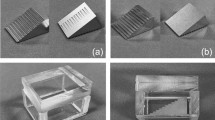Abstract
The aim of this study was to compare the depiction ability of small grayscale contrasts in ink-jet printouts of digital radiographs on different print media with CRT monitor. A CCD-based digital cephalometric image of a stepless aluminum wedge containing 50 bur holes of different depth was cut into 100 isometric images. Each image was printed on glossy paper and on transparent film by means of a high-resolution desktop inkjet printer at specific settings. The printed images were viewed under standardized conditions, and the perceptibility of the bur holes was evaluated and compared to the perceptibility on a 17-in CRT monitor. Thirty observers stated their blinded decision on a five-point confidence scale. Areas (Az) under receiver operating characteristics curves were calculated and compared using the pair wise sign tests. Overall agreement was estimated using Cohen’s kappa device and observer bias using McNemar’s test. Glossy paper prints and monitor display revealed significantly higher (P < 0.001) average Az values (0.83) compared to prints on transparent film (0.79), which was caused by higher sensitivity. Specificity was similar for all modalities. The sensitivity was dependent on the mean gray scale values for the transparent film.


Similar content being viewed by others
References
Geissler O, Rother U (2007) The film-based printout using tetenal printing solution II. Int J Comput Dent 10:285–291
Wenzel A (1999) Matters to consider when implementing direct digital radiography in the dental office. Int J Comput Dent 2:269–290
Schulze RKW, Schulze D, Voss K, Rottner M, Keller H-P, Dollmann K, Maager B, Wedel M (2008) Quality of individually calibrated customary printers for assessment of typical dental diagnoses on glossy paper prints: a multicenter pilot study. Oral Surg Oral Med Oral Pathol Oral Radiol Endod 106:578–586
Combs MJ, Snell J, Cail WS, Maier T, Buck DA (1995) The gray-scale ink jet printer: value in making hard copies of digital images. Am J Roentgenol 164:225–227
Kirkhorn T, Kehler M, Nilsson J, Lyttkens K, Andersson B, Holmer N-G (1994) Demonstration of digital radiographs by means of ink jet-printed paper copies: pilot study. J Digit Imaging 5:246–251
Lyttkens K, Kirkhorn T, Kehler M, Andersson B, Ebbesen A, Hochbergs P, Jarlman O, Lindberg C-G, Holmer N-G (1994) Evaluation of the image quality of ink jet-printed paper copies of digital chest radiographs as compared with film: a receiver operating characteristic study. J Digit Imaging 7:61–68
Gijbels F, Sanderink G, Pauwels H, Jacobs R (2004) Subjective image quality of digital panoramic radiographs displayed on monitor and printed on various hardcopy media. Clin Oral Investig 8:25–29
Otis L, Sherman RG (2005) Assessing the accuracy of caries diagnosis via radiograph. Film versus print. J Am Dent Assoc 136:323–300
Goodman LR, Wilson CR, Foley WD (1988) Digital radiography of the chest: promises and problems. Am J Roentgenol 150:1241–1252
Weinstein LM, Fitzer MS, Fitzer PM (1975) Detail enhancement in prints of radiographs. use of a linear radial transmission filter. Radiology 115:726–728
Bley TA, Kotter E, Saueressig U, Springer OS, Fisch D, Ghanem NA, Langer M (2003) Using receiver operating characteristic methodology to evaluate the diagnostic quality of radiography on paper print versus film. AJR Am Roentgenol 181:1487–1490
Bednarek DR, Rudin S (1991) Blurred-mask density compression for improved reproduction of radiographs. Invest Radiol 26:358–363
Benediktsdottir I, Wenzel A (2004) Accuracy of digital panoramic images displayed on monitor, glossy paper, and film for assessment of mandibular third molars. Oral Surg Oral Med Oral Pathol Oral Radiol Endod 98:217–222
Agresti A (1989) An agreement model with kappa as parameter. Stat Probab Lett 7:271–273
Hubert L, Golledge RG (1983) Rater agreement for complex assessments. Brit J Math Stat Psychol 36:207–216
Landis JR, Koch GG (1977) The measurement of observer agreement for categorical data. Biometrics 33:159–174
Conflict of interest
The authors declare that they have no conflict of interest.
Author information
Authors and Affiliations
Corresponding author
Rights and permissions
About this article
Cite this article
Kühl, S., Krummenauer, F., Dagassan-Berndt, D. et al. Ink-jet printout of radiographs on transparent film and glossy paper versus monitor display: an ROC analysis. Clin Oral Invest 15, 351–356 (2011). https://doi.org/10.1007/s00784-010-0400-3
Received:
Accepted:
Published:
Issue Date:
DOI: https://doi.org/10.1007/s00784-010-0400-3




